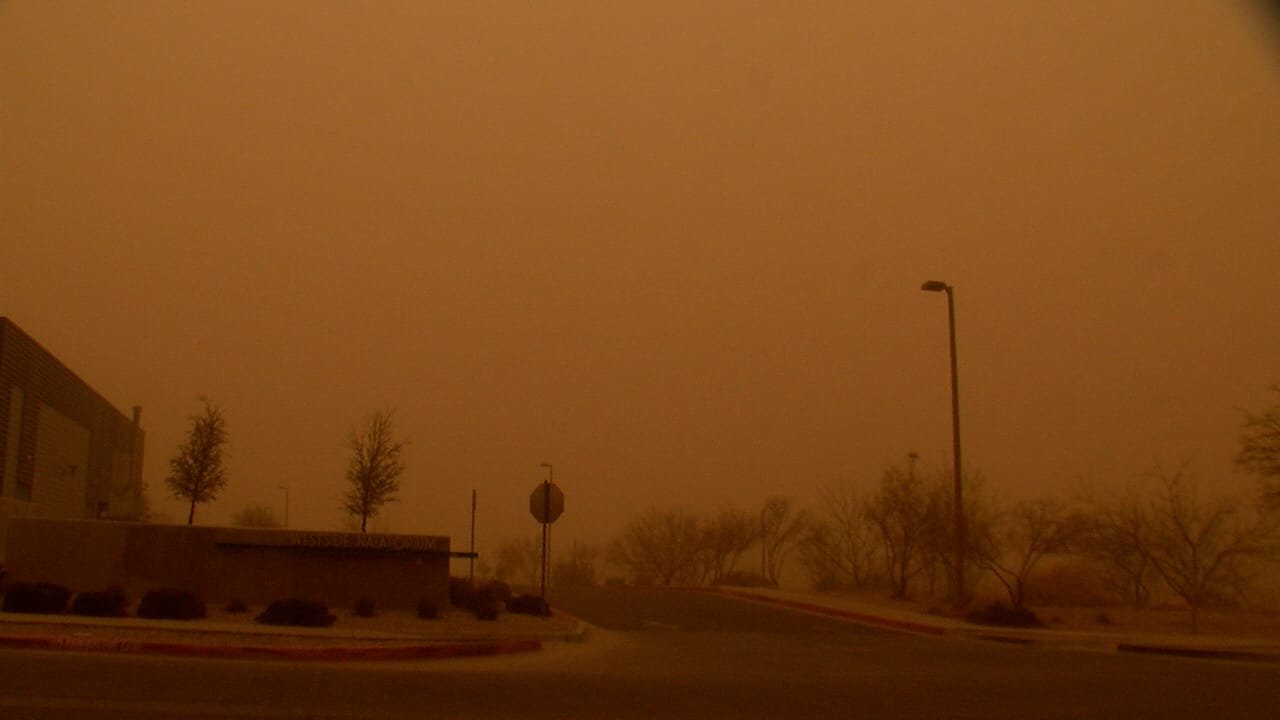State Issues Warning About Health Risks from Dust Storm

Dust Storm in counties like Doña Ana and Luna are now exceeding the federal guideline for particulate matter (PM10) on several days of the year prompting the New Mexico Department of Health to issue an advisory. Residents are finding it more difficult to breathe properly as a result of these storms’ temporary increases in pollution particularly for individuals who have heart disease COPD or asthma. The risk of respiratory distress and cardiovascular strain is increased by minute particles that are mixed up during these episodes and can enter the bloodstream and lungs deeply according to medical professionals.
The department’s Chief Medical Officer Dr. Miranda Durham stressed that even a short period of Sandstorm exposure might result in airway inflammation. At-risk groups are being urged by the state to employ indoor air recirculation settings, limit their exposure to the outdoors during storm alerts and adhere to their prescribed treatment programs without deviation. Public health bulletins and local weather warnings are used to offer updates on the continuous monitoring of air quality.
Table of Contents
What is a Dust Storm?
Strong winds that raise dust and sand particles from arid surfaces can cause a Sandstorm which lowers visibility and degrades the quality of the air. In arid areas with loose soil and little vegetation such deserts these storms are most frequent. Sandstorm can exacerbate pre-existing diseases like asthma and cause respiratory issues and eye irritation. Dust storms can make transportation and outdoor activities hazardous even though they often pass quickly. It is advised to stay inside close doors and windows and if at all feasible utilize air filtration equipment in order to be safe.
Potential Health Risks of Dust Storms
Health can be seriously impacted by Sandstorm especially the cardiovascular and respiratory systems. These storms’ elevated particulate matter levels can cause problems like worsened asthma lung infections and diminished lung function. Long-term exposure increases the chance of developing more severe illnesses such as lung cancer and heart problems. It is advised to use air purifiers stay inside and close doors and windows for safety. During dust storms it’s also critical to keep an eye on air quality readings.
Who is Most at Risk During a Dust Storm?
People with respiratory disorders such as asthma heart illness the elderly pregnant women and those with compromised immune systems are particularly vulnerable during a Sandstorm. Veterans and those employed in construction or agriculture who have previously been exposed to dust also experience more health issues. These groups should stay indoors stay out of the great outdoors and utilize air purifiers to limit their exposure to dangerous particles.
Precautionary Measures to Take During a Dust Storm
To lessen exposure during a dust storm stay inside keep windows closed and use air purifiers. Wear a N95 mask if you have to go outside. Employees should stop working and switch to filtered air-conditioned equipment. Avoiding soil disturbance and limiting outdoor activities are important safety measures to reduce health hazards.
What to Do if You Experience Health Issues?
Dust storms have a major impact on air quality because they increase particulate matter and increase the risk of cardiovascular and respiratory illnesses. Research indicates that during dust storms there is a 13% increase in car accidents and a 6% increase in emergency room visits related to asthma. Dust storms are a contributing factor to air pollution which raises increasing public health concerns according to the World Health Organization. It’s important to keep up with local air quality during these events and take preventative measures like remaining inside donning N95 masks and avoiding physically demanding activities to safeguard your health.
State Response and Preparedness Plans
The National Winter Contingency Plan 2024 2025 was created by Pakistan’s National Disaster Management Authority (NDMA) to prepare for Sandstorm and other weather-related emergencies. Early monitoring readiness and mitigating the effects of climate change are the main objectives of the plan. For efficient disaster response it places a strong emphasis on collaboration between federal state and local agencies. A comprehensive strategy to lessen the impact of dust storms on public health and safety is outlined in the NDMP 2025.
How to Stay Safe During Future Dust Storms
It’s important to stay inside during dust storms and keep windows closed to reduce exposure to dangerous particles. Wearing a N95 respirator might help filter out dust if you must go outside. To lessen particle matter utilize indoor air filtration systems and stay away from outdoor activities that disrupt the soil such as gardening. In order to control dust exposure and improve lung protection the World Health Organization also suggests limiting outdoor activities and use HEPA air purifiers.

Conclusion
To sum up dust storms pose major health concerns particularly to those who have respiratory disorders. Staying indoors wearing N95 masks when you walk outside and using air purifiers indoors are all crucial for your safety. By taking these safety measures you may reduce your exposure and safeguard your health during dust storms.






